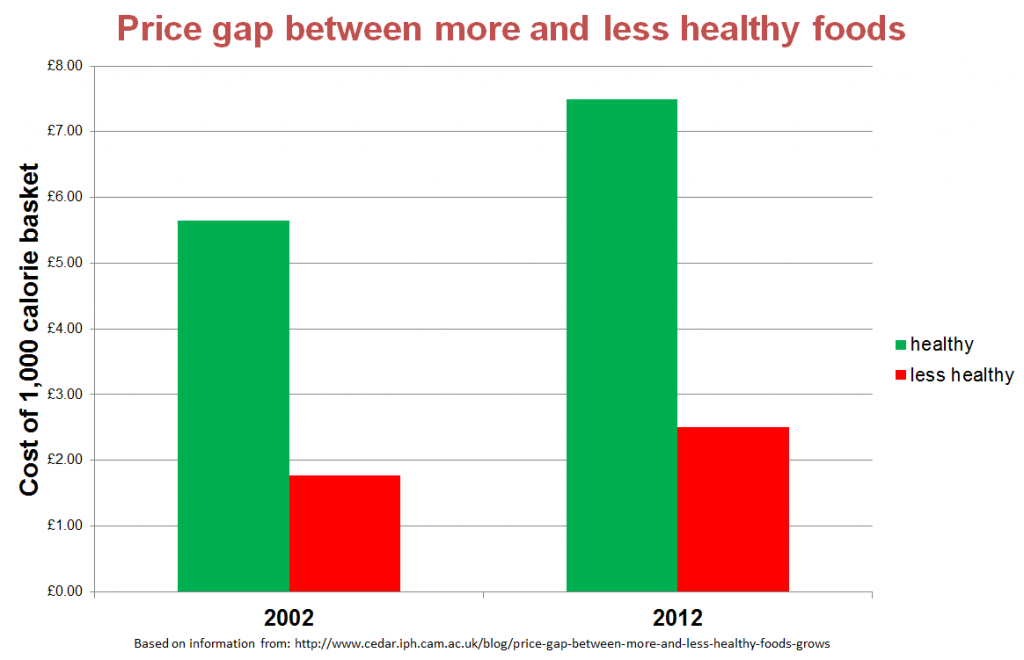Friends, who work in the food industry, think they do a superb job making food that’s both easy to serve and affordable. A book I read in the 70’s told me that the mission statement of Marks and Spencer was to subvert the class structure of Britain by making items available to the working classes that previously only the upper classes could afford! I can remember the excitement of having a Chicken Kiev for the first time! The example of Chicken Kiev is interesting. Most of us tend to think it’s a traditional dish, probably from the Ukraine. However I think it’s origins are French – and it was originally made with veal.
Posh restaurants changed it to chicken, because it was more expensive! Now you can buy two Chicken Kievs and get change from £1! How did this come about?
We can thank factory farmers for bringing down the price of chicken. I think most people would be appalled if they walked through a modern intensive poultry farm.
The few that allow cameras in are probably the better ones, in terms of animal welfare. Due to their intensive rearing, a typical supermarket chicken today contains more than twice the fat, and about a third less protein than 40 years ago.
How can the supermarkets sell food so cheaply? A look at the ingredients gives us a clue. In the one I looked at there was less than 50% chicken! The ingredients listed were:
“Chopped and Shaped Chicken Breast Mix with added Water and Soya Protein (67%) [Chicken (48%), Water, WHEAT FIBRE (contains Gluten), Tapioca Starch, SOYA PROTEIN ISOLATE, Stabilisers (Triphosphates), Salt, White Pepper] , Garlic Butter (10%) [Unsalted Butter (from MILK), Garlic Powder, Sugar, Parsley, Citric Acid, Flavouring] , Rapeseed Oil , Fortified Wheat Flour and Wheat Flour Blend [Fortified Wheat Flour [WHEAT FLOUR (contains Gluten), Calcium Carbonate, Iron, Niacin (B3), Thiamin (B1)], WHEAT FLOUR (contains Gluten)] , Salt , Dextrose , WHEAT SEMOLINA (contains Gluten) , Maize Starch , WHEAT GLUTEN , WHEAT STARCH (contains Gluten)”.
The problem, as I see it, stems back to the industrial resolution, when workers left the land and moved into cities. Factories sprung up, producing cheap processed food.
There’s a long history of the food industry buying cheap ingredients, and then adding flavouring, sugar and salt to make it more appealing. I can recommend reading Swindled: From Poison Sweets to Counterfeit Coffee – The Dark History of the Food Cheats by Bee Wilson. I’ve used chickens as an example, but I could have used many others. It’s frightening when you read the real reasons why prawn are now so cheap, and you’ll probably want to cut them out of your diet when you read more (see here for an example). Another good read is Felicity Lawrence’s Not On the Label: What Really Goes into the Food on Your Plate. It’s shocking that, after the horse meat scandal, I’m struggling to find evidence of prosecutions etc.
As supply chains have lengthened, we’ve become more distanced from food producers. A small producer probably wouldn’t bother to substitute a cheaper ingredient to save a penny – but if you’re producing 100,000+ then saving a penny can add thousands to the bottom line.
One of the main problems is lack of education. The eminent Professor John Webster told me in the 70’s the British public profess to have an interest in animal welfare, until they walk through the supermarket door and buy the cheapest food there is! Thirty years on and his message hasn’t changed (see here for example).
When I buy a chicken, I’m surprised how many meals I get out of it. I buy a good one, and bulk it out with pulses and vegetables. Nothing goes to waste, I always make a stock out of the carcass.
A recent report, by The Centre for Diet and Activity Research (CEDAR), looks at the growing price gap between more and less healthy foods. According to the report, healthy foods in 2012 were three times more expensive per calorie than less healthy foods:
It’s no wonder obesity is increasing. When I look in shops like B & M and Home Bargains I see lots of cheap, but heavily processed foods. We’re lucky, where I live, to still have a greengrocer. Many places no longer have one…
I welcome programmes like Jamie’s 15 minute meals, which show you that you can make tasty, reasonably priced meals in no time at all without resorting to packets and ready meals. I also commend Joanna Blythman’s What to Eat: Food that’s good for your health, pocket and plate – follow her guidelines and you can eat better and help save the planet.





Well done. Brilliant article. The problem is wanting to eat healthily as well. I think laziness is the biggest cause of obesity, added to wrong diet. I don’t agree That you can lose weight by physical exercise. It is only part of a healthy life style. I have 3 children. 2 eat healthily as do their families. The third eats well. Feeds the family well, exercises a little. The 2 boys are slim, as is her 6’7’ husband. The problem is although she gets plenty of exercise, she cheat, as I do, on her otherwise healthy diet. Result 2 fat ladies.
I shall follow your page in the future. I shall persist in healthy eating, but try to cut out the rubbish in between. This comes from kind people who feel obliged to bring cakes, biscuits or chocolate when they visit.
Ah well!
It was so good seeing you. Thanks for your help. Much, much appreciated.
Love, Lynda